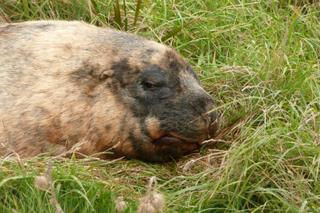The Catlins Coast is a scenic drive from one Scottish influenced city, Invercargill close to another, Dunedin. Before long we were off-roading on dodgy gravel roads reminiscent of our Australian driving days. The first stop was Waipapa Point, but just before we got there we noticed a huge sea lion sleeping in the grass at the side of the road. The guidebook informed us that it was a Hooker’s sea lion and that they can get quite aggressive, although it felt pretty safe photographing him from the safety of our car. It was a bit too cold at Waipapa Point to venture too far but we did come across another sea lion that raised his head and check us out in a way which told us not to mess!
The next stop was Slope Point, the most southerly point on the south island, so of course a flag photo was required. It was pretty cold and blustery on the cliff, but then it would be when the next point of land is the Antarctic! It’s not often you can say that!
Lunch at Porpoise bay introduced us to the smallest and rarest species of dolphin; the Hector’s dolphin. Aparently this is the only place in the world where dolphins live permenantly so close the shore. There is not much of them to see from a distance as their dorsal fins are small and only occasionally pop out of the water, but they were spotted doing their dolphin thing, swimming around the bay and doing wee acrobatic jumps every now and then.
Our next stop involved a pleasant walk through a very moss covered forest to get to McLean falls, followed by a much needed (it was cold and overcast!) cafe stop for coffee and scones. By now time was getting on and we would have to pass all the other waterfall stops and hightail it to Nugget Point so that we might be able to see another rare species.
Darkness, or greyness at least was beginning to set in on the long and rough gravel road to Nugget Point. But it was worth the effort and enduring Si’s strategy for coping with all the bumps in the road – just drive faster! As soon as we got to the beach we walked down to a hide and were just in time to see several Yellow-Eyed penguins come ashore for the evening. Considered the most ancient of all living penguins these guys are endangered and the rarest of penguins. They are bigger than the Little Blue penguins and much much shyer and more wary. They took a very long time to make their way to their nests with several changes of mind and direction along the way. They also entertained us with a tummy slapping greeting, which thanks to the photographic skills of Si have been caught on video. The return drive on the gravel road in the dark was pretty hairy but we made it to a campsite in one peice where we could enjoy the luxury of having a powered site by keeping the fan heater on all night.
Skip to content

Simon & Caroline's World Tour 07/08
or, the long way round to Scotland…